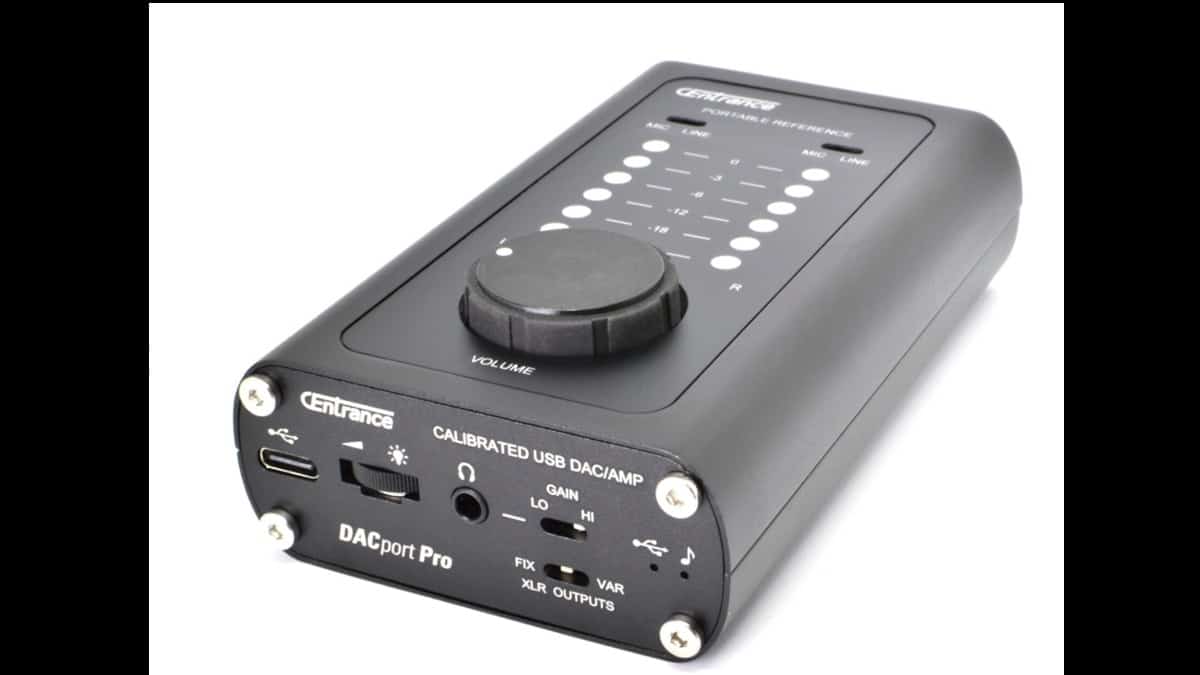Audio Hardware
CEntrance DACport Pro USB DAC, Headphone Amp, and Monitor Controller – Exclusive Synth and Software Review

Will this portable reference really turn your softsynth-running laptop into a legitimate musical instrument? Nick Batzdorf hooks it up and plugs in some speakers and headphones.
It makes sense for a lot of applications: a 2-out stereo audio interface with no inputs. Why spend the money on inputs you’re not using if, oh, say, you’re only playing softsynths and sample libraries by MIDI?
That’s the DACport Pro, CEntrance’s latest in their series of utilitarian audio products. It has “Portable Reference” screened on its surface. And that’s what it is: a portable, high-quality reference headphone amp and solid pair of audio outputs on balanced XLR plugs, suitable for studio and live performance use. It’s also billed as a monitor controller, albeit an extremely basic one – but then that may be all that many musicians need.
While all three of the outputs-only boxes within CEntrance’s line are designed for different applications, the DACport Pro is priced in the middle of the price range. Its $370 tag is about double their $180 DACport HD headphone amp and half their $750 HI-FI M8, a relatively high-end audiophile headphone amp.
Hardware: The DACport Pro is a well-made little black box (roughly 1” x 2-1/2” x 4-1/2”) that couldn’t be simpler. There’s not even any reason to detail the features here, because the massive instruction manual, which contains everything you need to know, consists of two sides of a little card.

The DACport supports Windows, Mac, and Linux, and it’s USB Class-Compliant. That’s Class-Compliant in caps, meaning “plug-and-play” so you don’t need an additional driver from the one built into the computer’s operating system – although there is an optional ASIO driver for Windows available on the CEntrance website.
Two balanced male XLR outputs are on the rear, switchable between line level for standard connections to amps (either built into powered monitors or stand-alone power amps), and mic level if you’re plugging it into a mixer. You select the level, and whether the outputs are fixed or variable using the volume knob, with recessed sliding switches.
CEntrance says they recessed the switches to prevent you from toggling them accidentally in the throes of a performance. They do slide easily with no fuss, using either the included tool that you’re guaranteed to lose, or something like a paper clip or toothpick. Tests have proven that a ballpoint pen works too, but it’s not recommend for removing corn from between your teeth.
Monitor control: The volume knob does feel very nice, and it has a nice long travel that avoids sudden volume jumps. It’s that volume knob that allows the DACport Pro to be considered a monitor controller for one set of speakers.
This is an analog level control, not a digital encoder. That ensures you won’t lose low-level detail, as you can when lowering a digital signal. By definition, reducing the digital level means lowering the number of bits representing the signal, so the lowest bits can get pushed below the bottom bit. On that subject, the DACport Pro supports up to 32-bit signals at sample rates up to 384kHz and DSD.
One limitation for monitor control use, however: the single volume knob affects both the headphones and the XLR outputs (when they’re set to be variable) simultaneously. That may or may not be an issue, since you’re probably on stage if you’re using both, in which case you have the DACport Pro’s outputs connected to an amp or mixer with their own adjustments. But it does mean you can’t set the levels of the two independently and switch between them.
The 6-light level meters are factory-calibrated to 0dBFS of the incoming USB stream from the computer, rather than the output. That’s logical and standard for an audio interface, but it does mean the meters are unaffected by the setting of the volume control, as one might expect from meters in a monitor controller.
Sound: Unfortunately there’s no way to demonstrate the DACport Pro’s audio quality here, so we’ll have to resort to adjectives.
The headphone amp is clean and powerful, and it has no problem driving 600Ω AKG 240Ms, as well as the Bose QuietComfort IIIs, both used for this review. It’s also very quiet. CEntrance recommends the low setting for IEMs (in-ear monitors) and other sensitive earphones, but we kept the level on high for the duration.
Compared to the built-in audio on an iPhone and even more so on a Mac laptop, well, there is no comparison – the DACport Pro’s headphone amp sound is just in a different league. The difference between this modern headphone amp and the perfectly decent one built into the $1800 8×8 Metric Halo audio interface in my studio is less stark, but it does sound smoother and rounder. You can hear that best on vocals.
The line-level outputs are also so much better-sounding than the ones built into the Mac laptop that it’s almost silly. They don’t sound dramatically different from the above-mentioned audio interface’s outputs, which is to say that the difference isn’t enough to be obvious after the amount of time it takes to switch the cables. But it does say that this is a very good-sounding little box.
Bottom line, the DACport Pro is built solidly, priced well, it has a nice headphone amp, and it generally does what we’d want from it: turn a laptop running softsynths and sample libraries into a credible-sounding stage or studio instrument.
Prices as of this writing (rounded up to the nearest $): $370, optional protective case $20, clamp mount $40, tripod $50.

















